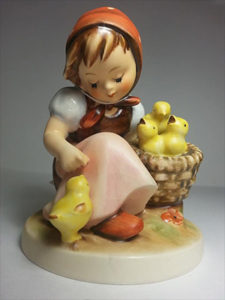 More than likely, you are familiar with the name of M.I. Hummel which represents some of the finest German porcelain figurines you are able to purchase. There is also a new name very similar, Berta Hummel, that bears a striking resemblance to the M.I. Hummel figurines. I did a little research into this look-alike and found some valuable information on what you should look for in future purchases. The following may help you as well, I hope.
More than likely, you are familiar with the name of M.I. Hummel which represents some of the finest German porcelain figurines you are able to purchase. There is also a new name very similar, Berta Hummel, that bears a striking resemblance to the M.I. Hummel figurines. I did a little research into this look-alike and found some valuable information on what you should look for in future purchases. The following may help you as well, I hope.
This page was updated on 23 February 2021.
Berta vs M.I. Hummel
Berta Hummel (1909-1946) was the artist’s name before she adopted the religious name of Maria Innocentia Hummel in 1931 after she entered the Catholic congregation as a postulant, hence the name M.I. Hummel.

“Berta Hummel” was another extension of the Goebel company which had been producing the M.I. Hummel figurines, plates and other items associated with this name beginning in the year 1935. There are some very evident differences between the two. One of these is that the Berta Hummel items are produced in the Far East (ie. – China, Thailand) instead of Germany but it is also under the supervision and scrutiny of the Goebel company. The Berta Hummel is also made of bisque porcelain to reduce costs instead of the preferred porous earthenware which has to be fired in a kiln a number of times (Swanson, 2017).
A good illustration as an example is the Goebel of Spring Blossoms, BH 3/2/0 made in China as shown above. I noticed that the Berta Hummel figurines each have the letters “BH” and then the number of the item. The box these come in also has a printed label quite different showing the phrase “StudioHummel“.
Here is a quote that better explains the differences. “Until 2007, a line of figurines called Berta Hummel was produced in Asia. Less expensive than the M. I. Hummel figurines made in Germany, they were approved by Hummel’s nephew, not by the convent that has always had approval rights on M. I. Hummel designs. Berta Hummel figurines were based on drawings that Sister Maria Innocentia Hummel made before she became a nun. They superficially resemble M. I. Hummel figurines, but should not be confused with them and have very little re-sale value” (Viator, 2008).
The Berta Hummel figurines are very nice but you can tell there is a noticeable difference when they are placed side by side. The texture is quite different and the base is another clue. The M.I. Hummels are fired in a kiln multiple times at very high temperatures during a multiple step process of glazing, face details, painting of the colorful clothing, and then a clear coat.
You may also find recently that there are a number of other companies that were granted a limited license for their Hummel related products. A quick search yielded a few that include:

Another major offshoot of the Hummel figurines is the example to the right from the Danbury Mint version of the M.I. Hummel Chick Girl (57/I) called Gentle Moment. The differences that really stand out are that the Danbury Mint version has painted dots on the white sleeves as well as flowers on the skirt whereas the M.I. Hummel is plain but does have spots painted on the head scarf that the Danbury Mint version does not.

There may be other subtle differences The manufacturer’s information on the bottom of each figurine is also quite different but the Danbury does have inscribed 57/1 and is stamped “The Danbury Mint Exclusive, Hummel Manufactur, Made in Germany”. A description of the chicken house base and the little girl is, “The base with hen house, fence with egg sign, and tree is cold cast porcelain / earthenware. The little girl with chick figurine is matte finish ceramic.” Note that the chicken house scene to the left in the photograph has a small gold sticker showing that it is made in China.
As a side note, I have noticed that earlier M.I. Hummel versions of the Chick Girl, 57/0, have only two yellow chicks in the basket but the larger version, 57/I and the bookend Chick Girl 61/B have three yellow chicks.

The Danbury Mint advertises one of their items, The M.I. Hummel Christmas Village, as “meticulously crafted of cold-cast porcelain, a special blend of powdered porcelain and resin prized by artisans for its ability to capture the tiniest details and textures.” The original German made M.I. Hummel figurines were made from porcelain slip poured into a mold, then fired at high temperature as many as four times or more.
According to the Goebel history page, in 2008 Goebel is no longer creating the Hummel figurines as they are now crafted by the company Manufaktur Rödental.
References
- ARS AG – miHummelLicensing.com
- Danbury Mint – Danburymint.com/Collectibles/SearchResult?Keywords=hummel
- Goebel – Goebel.de/en/content/history-love-porcelain
- Manufaktur Rödenta – HummelFiguren.com
- Swanson, E. (Dec 31, 2017). Difference Between Berta and M.I. Hummel Figurines
- Viator, J. (Oct. 2008), “Farewell” to “Merry Wanderer”…
- Willabee & Ward – WillabeeandWard.com/prod/B5D/0390-0024/M-I–Hummel-Magnets